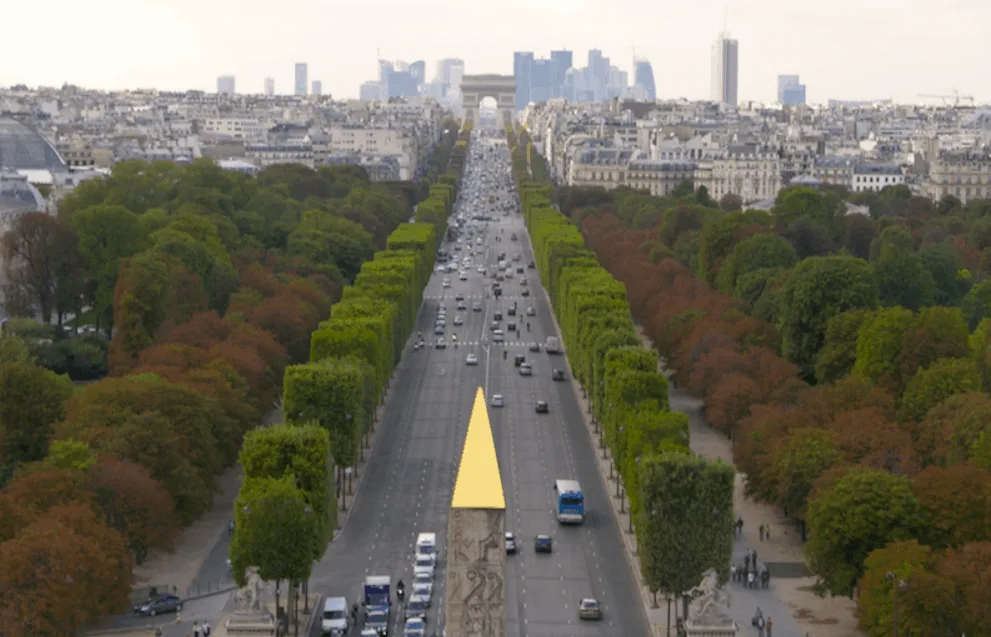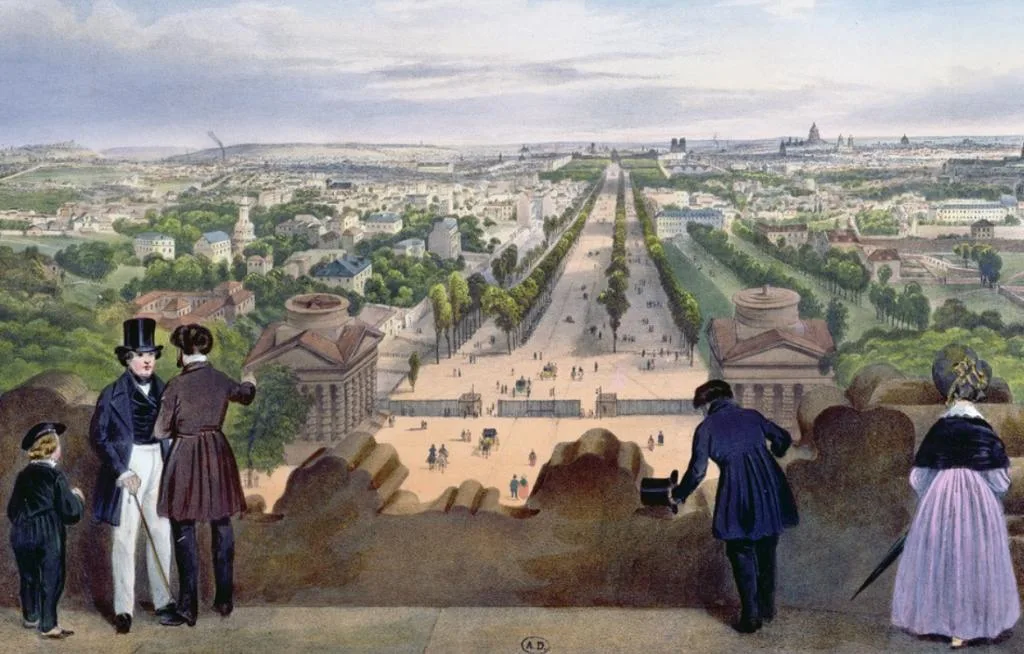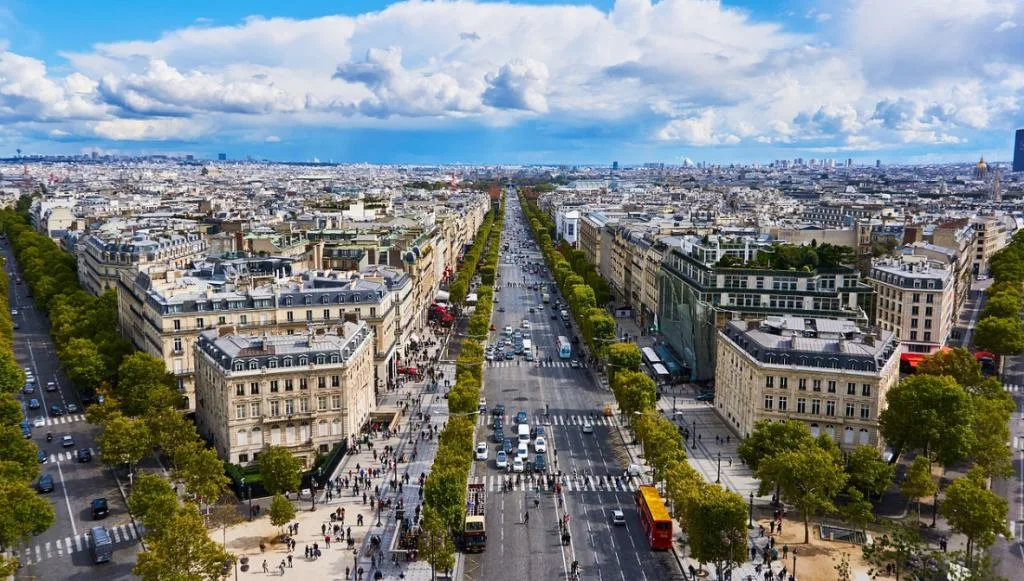One of the most famous avenues in Paris is the “Avenue des Champs-Élysées”, or simply referred to as the “Champs-Élysées.”
The Champs-Élysées is about 1.9 kilometers long and connects the Place de la Concorde and the Arc de Triomphe which is located on the Place Charles de Gaulle.
It’s not just a very long avenue located in the 8th arrondissement of Paris, it’s also nearly 70 meters wide and has massive sidewalks.
It’s fair to say that the Champs-Élysées is one of the most famous and well-known avenues in the entire world.
In this post, we’ll take a closer look at some interesting facts about the Champs-Élysées, the most famous avenue in Paris and beyond.
1. Why is the avenue called the Champs-Élysées?
The Champs-Élysées literally translates from French to Elysian Fields and is derived from Greek Mythology.
It’s a conception of the afterlife as to where all the Gods and heroes will stay to live a blessed and happy life with whatever they wish.
In other words, it simply means paradise for all the heroes that passed away.
Fun fact about the Champs-Élysées: The avenue wasn’t called like this until 1709. before this moment, it was either called the “Grand Cours”, or “Grand Promenade.”

2. Where is the Champs-Élysées located

The Champs-Élysées is located in the 8th arrondissement in Northwestern Paris. The lower part of the avenue runs through the “Jardin des Champs-Élysées” which translates to the “Garden of the Champs-Élysées.”
This garden is a park that contains several historical buildings such as:
- The Grand Palais
- The Petit Palais
- The Théâtre Marigny
- Multiple other interesting monuments
The Champs-Élysées is part of the “Axe Historique” in Paris, which runs from the center of Paris to the west, and contains numerous important historical buildings.

Below you can see a visual looking down the Champs-Élysées and most of the “Axe Historic” looking west from Place the la Concorde.
In the foreground, you can see the “Obélisque. In the end, you can see the business district “La Défense” where the Axe Historique stops.

3. Nothing was there until Louis XIV’s reign
Every monumental street needs to start somewhere, and for the Champs-Élysées this happened when Louis XIV became the King of France.
In 1667, the plan for the avenue was laid out, but it was actually to extend the gardens of the Tuileries Palace, which had been built nearly 100 years earlier in 1564.
The avenue was extended up until the “Place d’Étoile,” currently known as the “Place Charles de Gaulle” in 1710.
Another extension took place in 1774 up until the “Porte Maillot,” which made the Champs-Élysees exactly as long as it is today.
4. Property of the City of Paris
In 1828, the Champs-Élysees became officially the property of the city of Paris. This means it could start creating the fashionable avenue we know today.
This was one of the most important facts about the Champs-Élysées. The city had from then on the authority to make improvements such as adding footpaths, fountains, and street lighting.
Shortly after in 1834, an architect named Mariano Ruiz de Chavez was assigned by King Louis Philippe to redesign the place de la Concorde and the gardens of the Champs-Élysees.
He kept the garden intact and made it a public entertainment spot where Parisiens could relax and enjoy a bit of nature.
Here you can see a sketch from that period from the top of the Arc de Triomphe with at the very end the gardens near the Place the la Concorde.

5. German Troops followed by French and Americans
The German troops actually marched on the Champs-Élysées twice after victory. The first time was after their victory in the Franco-Prussian war in 1871.

The second time was when the nazi regime under Adolphe Hitler invaded France and conquered Paris. This happened on June 14, 1940, after France surrendered.

The Germans were finally defeated in 1944, and the victory parades of Germans made way for the 28th Infantry Division to march down the Avenue des Champs-Élysées in the Victory Parade on 29 August 1944.

3 days before the Americans, the French already held their victory parade when the Free French 2nd Armored Division marched down the Champs-Élysées on 26 August 1944 to celebrate the Liberation of Paris.

6. Yearly military parade
The French national day, also referred to as “Bastille Day” or “le 14 Juillet” is the day that France remembers the “Storming of the Bastille,” one of the major turning points in the French Revolution.
To commemorate this moment, a big military parade is held on the Champs-Élysées which is considered to be the largest military parade in Europe.
The parade includes all the highest-ranking military people of France, as well as the president of the republic himself.

7. Stores on the Champs-Élysées
To maintain an enjoyable atmosphere on the most famous avenue in Paris, the oldest committee in Paris works close together with the City government.
The city of Paris is afraid of something called “banalisation,” meaning that just about any global chain could simply open a store resulting in the Champs-Élysées losing their unique character.
In 2007, a branch from the famous chain H&M was refused to open a store. After a lot of lobbying, they were allowed to open it up two years later anyways.
The Champs-Élysées is most known for its luxury and expensive shops of the world’s most exclusive brands.

8. The end of the Tour de France
One of the biggest cycling events in the world is the Tour de France. It’s been held annually since 1903 and cyclists travel all across France and surrounding countries in a 21-day race.
The final stage of the Tour de France is monumental, as the peloton rides into Paris, and finishes in style on the Champs-Élysées. This is the case since 1975.
The winner is celebrated on a stage put directly on the avenue and other awards are also given there.
It’s a fitting finale for an amazing yearly event.

9. A place to celebrate or protest
Human emotions and passion can sometimes need to be expressed. Where can they be expressed better than on an epic stage as the Champs-Élysées?
One of the most famous avenues in the world is sometimes the stage of huge celebrations, but it can also be used as a platform for political protest.
Let’s say that to magnify the beauty of the Champs-Élysées along with all its history, we definitely prefer the huge explosions of joy.

